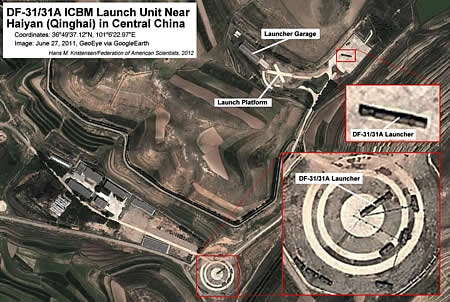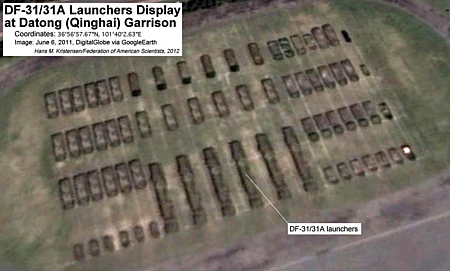Chinese Mobile ICBMs Seen in Central China
 |
| Road-mobile DF-31/31A ICBM launchers deploying to Central China are visible on new commercial satellite images. Click on image for larger version. |
.
By Hans M. Kristensen
Recent satellite images show that China is setting up launch units for its newest road-mobile Intercontinental Ballistic Missile (ICBM) in central China. Several launchers of the new DF-31/31A appeared at two sites in the eastern part of the Qinghai province in June 2011. This is part of China’s slow modernization of its small (compared with Russia and the United States) nuclear arsenal.
An image taken on June 27, 2011 (see above), shows two DF-31/31A launchers on the launch pads of a small launch unit near Haiyan (36°49’37.12″N, 101° 6’22.97″E). One is positioned in a circular pad with support vehicles surrounding it. The circular pad was added to the facility sometime between 2005 and 2010. The other launcher is on a pad to the north, located next to an x-shaped launch pad and a missile garage. The layout of the Haiyan launch site is similar, yet not identical, to the DF-31 launch unit of the 813 Brigade at Nanyang.
Another image taken on June 6, 2011 (see below), shows six DF-31/31A launchers lined up on the parade ground at the 809 Brigade base in Datong about 50 kilometers (32 miles) to the east (36°56’57.67″N, 101°40’2.63″E). The brigade has been thought to be equipped with the DF-21 medium-range missile, but might be under conversion to the longer range DF-31/31A. It is unclear if the launchers are permanently based in the area or temporarily deployed from the 812 Brigade some 500 kilometers (290 miles) to the southeast.
 |
| Six mobile DF-31/31A launchers seen on display at a launch brigade in Datong, Qinghai, in central China in June 2011. Click image for larger version. |
.
With an estimated range of 7,200-plus kilometers (4,470 miles), the DF-31 cannot target the continental United States from Central China. But the modification known as DF-31A can with its estimated range of 11,200-plus kilometers (6,960 miles), reach most of the continental United States from Central China. The DF-31/31A missiles can target all of Russia and India from Central China.
Slow Deployment
Deployment of the DF-31 has been slow since it first entered service in 2006. Less than 10 missiles had been deployed with as many launchers by 2010, and not many more were added in 2011.
The DF-31A began deployment in 2007 with about a dozen missiles on as many launchers by 2010. Also counting 20 silo-based DF-5As, the U.S. intelligence community estimates that China currently has “fewer than 50” missiles that can target the continental United States, suggesting that less that 25 DF-31As are currently deployed. (The number is a little more uncertain now after the Pentagon in 2011 started supporting Chinese nuclear secrecy by no longer providing a breakdown of Chinese missile forces in its annual report on Chinese military power).
As older missiles with shorter range are retired and replaced by the DF-31/31A over the next decade, a greater portion of the Chinese missile force will be able to target the continental United States, perhaps twice as many by 2025. But even then, the Chinese force will be small compared with that of Russia and the United States.
Also visit: IMINT & Analysis and Project 2049
Analysis made possible by generous grants from the Carnegie Corporation of New York and the Ploughshares Fund.
This publication was made possible by a grant from Carnegie Corporation of New York and Ploughshares Fund. The statements made and views expressed are solely the responsibility of the author.
The FY2026 National Defense Authorization Act (NDAA) paints a picture of a Congress that is working to both protect and accelerate nuclear modernization programs while simultaneously lacking trust in the Pentagon and the Department of Energy to execute them.
While advanced Chinese language proficiency and cultural familiarity remain irreplaceable skills, they are neither necessary nor sufficient for successful open-source analysis on China’s nuclear forces.
Satellite imagery has long served as a tool for observing on-the-ground activity worldwide, and offers especially valuable insights into the operation, development, and physical features related to nuclear technology.
This report outlines a framework relying on “Cooperative Technical Means” for effective arms control verification based on remote sensing, avoiding on-site inspections but maintaining a level of transparency that allows for immediate detection of changes in nuclear posture or a significant build-up above agreed limits.